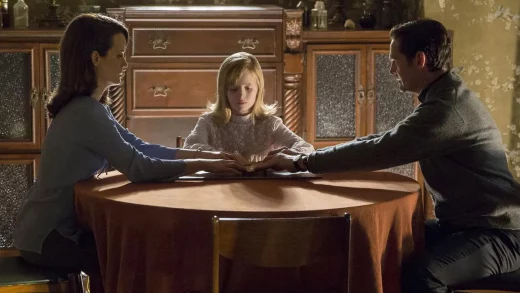:format(webp)/https://www.thestar.com/content/dam/thestar/entertainment/stage/2023/04/11/santee-smiths-new-work-homelands-and-her-kahawi-dance-theatre-the-life-sustaining-force-of-the-indigenous-choreographer/homelands_by_kaha_wi_dance_theatre.jpg)
It was a cool spring afternoon as Santee Smith, founder/director of Kaha:wi Dance Theatre, crossed the yard from her home on the Six Nations of the Grand River reserve to the nearby former pottery showroom — the Smith family were professional potters — that now serves as her studio. She and fellow Indigenous cast members Feryn King and Katie Couchie, all in practice clothes, soon launched into their first full run-through of “Homelands,” a new work by Smith examining Indigenous people’s spiritual bond with the land. “Homelands” has its premiere this Friday at Harbourfront Centre.
As the hour-long work unfolded, even without all the visual effects of the full production — lighting, projected imagery, props and costumes — it was still possible to be drawn into an almost magical realm in which the western theatrical concept of performance was quickly subsumed into something more evocative of ceremony and ritual; contemporary in mode, sacred in spirit.
The layered sound score supports what ultimately emerges as a cycle of seasonal episodes that reference aspects of Indigenous cosmology and customs, and the way the land remains constant as generations come and go.
As in much of Smith’s work, the choreography is a richly textured blend of gesture and bodily movements that seem to come from some deep inner energy source. It’s never merely decorative. Even if, as in “Homelands,” the work is semi-abstract, there is always a purpose behind it. In this instance, it is the yearning for traditional territories lost to the Mohawk nation through war, appropriation and betrayal.
As Smith recounted, in pre-colonial times, her ancestors inhabited lands stretching all the way down the Mohawk Valley and up into the Adirondack Mountains. After the American Revolution, those who had remained loyal and, like Joseph Brant, supported the British were driven north across the new border. Under the terms of a 1784 treaty they were promised a huge tract of land extending six miles on either side along almost the entire course of the Grand River. Today’s Six Nations reserve, a poor substitute for their lost homelands, occupies a small fraction of what had been promised.
“It’s all about the umbilical tie to the land,” said Smith, who has explored the territory her ancestors were forced to abandon. “When you return to your original homelands you feel a vibration, like some internal resonance. Something just clicks.”
“Homelands” is also a celebration of women and motherhood and their important place in Indigenous culture.
“In our culture, it’s all about balance,” Smith explained. “Balance within self, between people, with the environment, and equality of man and woman. It’s imbalance that causes distress and disease. Some of the dances that we have inside of this piece reference traditional dances about balance in nature and alignment with the universe.”
Smith has included men in several of her earlier works but knew from the start that “Homelands” would focus on women.
“Women took care of anything to do with life-sustaining forces,” Smith observed. “One of the ways to say woman, translated from Mohawk, is ‘life sustainer.’ We think of the Earth itself as Mother Earth. It’s not an exclusion of masculinity but an acknowledgment of the importance and powerfulness of women, and making those connections to our homelands and our grandmothers past.”
Although audiences primarily identify Smith as a dance artist, her personal journey has been far from conventional or straightforward, a reflection of her boundless curiosity and abundance of talents.
Lots of small children are instinctively motivated to dance when they hear music, but it took two nasty accidents to launch Smith into formal dance training. At age three she broke both legs in the same year. After the casts came off she was sent to a dance teacher in Brantford as a way of regaining strength in her legs, which she did. Smith also fell in love with dance as an artistic expression, so much so that at age 11 she entered the full-time professional training program at Canada’s National Ballet School in Toronto but quit after six years.
“I was confused about where I wanted to go in terms of my career,” said Smith. “I was not ready to commit to ballet. I’d also been removed from Six Nations for a long time and felt an urge to reconnect.”
Smith returned home, finished high school and enrolled at McMaster, the university in Hamilton where, decades later, she serves as its honorary and titular head in the role of chancellor. Smith graduated with a degree in physical education in 1994 and then pursued her interest in psychology, taking courses at the University of Toronto.
“Then I got sidetracked,” said Smith.
She was drawn to the work of Toronto’s Native Earth Performing Arts and began to train in theatre. Smith reconnected with dance in 1996 when celebrated Indigenous actor and musician Gary Farmer invited her to choreograph and perform in “The Gift,” a documentary he was making for the National Film Board about the important role of corn in Indigenous culture.
“It was an ‘aha’ moment,” said Smith. “It was my first choreography and a new possibility. I realized my whole body and creativity needed an outlet in movement.”
For several summers, Smith travelled to Alberta to attend the Banff Centre’s groundbreaking Chinook Winds: Aboriginal Dance Project. There she connected with such future collaborators as actor Raoul Trujillo and Alejandro Ronceria, now director of dance training programs at the centre. She also forged some of her earliest connections with Indigenous artists from abroad. Smith soon began work on an ambitious project for an evening-length work called “Kaha:wi” that in 2005 became the official name of her newly formed company.
The research involved in the making of “Kaha:wi” dovetailed nicely with a two-year project at York University that, in 2004, earned Smith a master’s degree in dance. She also completed a BA in psychology the following year at McMaster.
In the years since, Santee Smith has become one of Canada’s internationally best-known and respected Indigenous artists. She has taken her work to festivals as far away as Japan and New Zealand, produced her own festivals of international Indigenous dance here in Canada, and choreographed a growing body of work that honours and celebrates the values of her traditional heritage through a multidisciplinary medium of contemporary dance theatre.
Santee Smith knows that some of the symbolism embedded in her choreography might not fully reveal itself to non-Indigenous audiences but is confident they will find meaning of their own.
“It’s happening for everybody,” said Smith, “but it’s up to each individual to take what they will from it.”
JOIN THE CONVERSATION
does not endorse these opinions.



